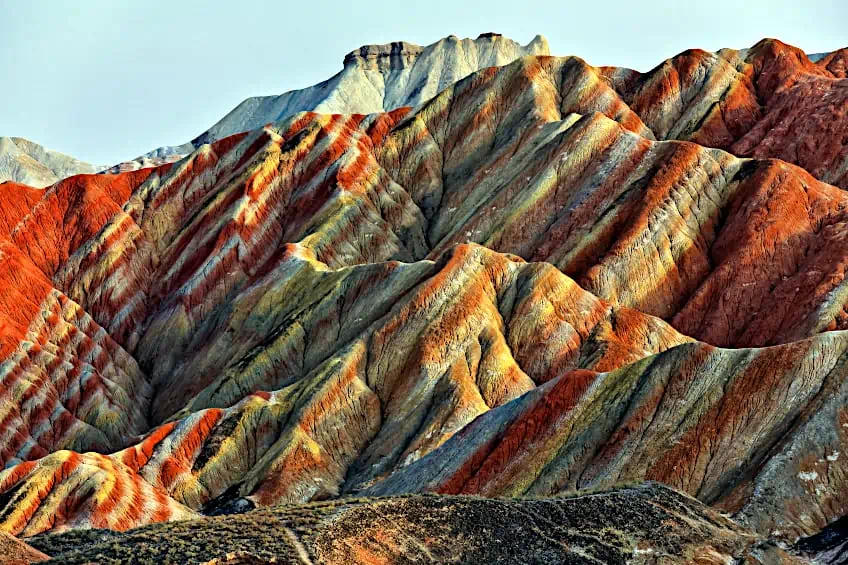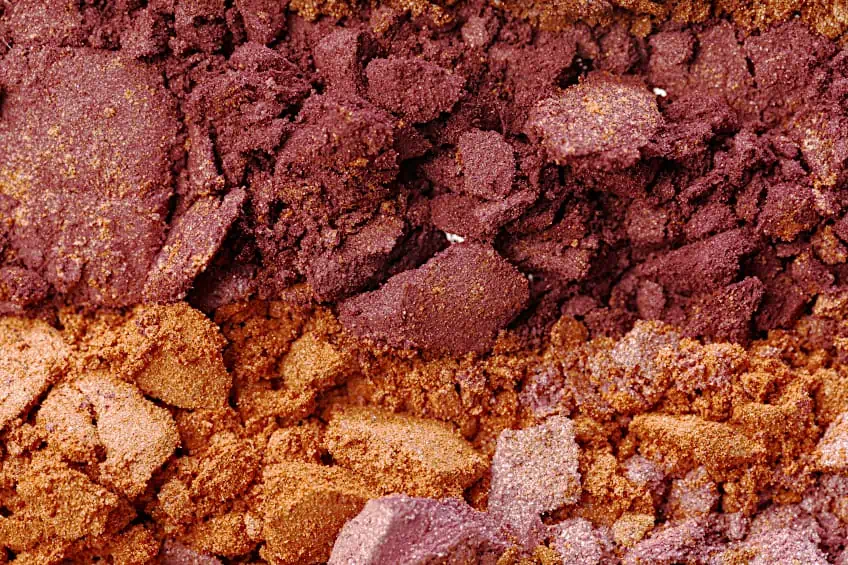Burnt Umber Color – How to Make and Use Burnt Umber
This post may contain affiliate links. We may earn a small commission from purchases made through them, at no additional cost to you.
The color of burnt umber can be found alongside natural earthy tones such as burnt sienna, raw umber, and yellow ochre. For centuries, natural pigments have been used in painting, as far back as prehistoric times. Not all artists and designers use burnt umber, but it can be a very impactful and important color to include in any color palette.
Table of Contents
What Color Is Burnt Umber?
Umber can be described as a brown, cool shade containing yellow-brown undertones. The undertones are a result of it containing iron oxide and manganese oxide. As previously mentioned, umber is an earth tone like ochre and sienna, yet it is a much darker color. The higher content of manganese oxide is what causes the color to be so brownish. You may be wondering where does burnt umber originate?

When it comes to raw umber vs. burnt umber, raw umber is the natural form of the pigment. Once heated, or “burnt” any moisture is removed from the pigment, altering the color to a darker, warm, reddish-brown.

Cyprus is where the largest deposits of raw umber are located. Umber is not a specific color and can be found in an array of different undertones and shades, all depending on the volume of minerals found within the pigment. This means that the many umber colors can vary from darker to lighter tones, with gray, red, or yellow undertones.

Burnt Umber: A Brief History
Burnt umber and other natural earth pigments have been utilized for centuries, as far back as the Neolithic era. In later years, in Umbria, Italy, the pigment could be found in abundance.

During the Baroque era, in the 17th century, burnt umber became particularly popular. Chiaroscuro was one of the techniques that was widely used at this time. One could create cast contrast between light and dark, which impacts the composition. Both Caravaggio and Rembrandt were among the many artists who applied this technique.

Self Portrait with Two Circles (1665-69) by Rembrandt created rich, brown color using burnt umber. However, as manganese is found in raw umber, which is a natural oxidizing agent, it dries quite quickly. Artists chose to use an underpainting technique, also known as painting groundwork, with these pigments so that they were able to work faster. They would also add raw umber to other color pigments to speed up the drying time. The following list is of paintings that have burnt umber incorporated into them.
- Portrait of Jorge Manuel (1603) by El Greco
- A Dance to the Music of Time (1634-1636) by Nicolas Poussin
- The Milkmaid (1650) by Johannes Vermeer
- Self-Portrait with Two Circles (1656) by Rembrandt
- Apollo the Lute Player (1665-1669) by Caravaggio
- Pictura (1661) by Frans van Mieras

To have an understanding of the color palette required to create flesh tones you can look at the painting by Mieras. Burnt umber was used by Vermeer to create shadows on the wall as it created a warmer color than black would. Later, in the 20th century, synthetic options replaced a lot of natural pigments. However, you are still able to find natural pigments today. If you want to make sure you are purchasing a natural source product, you need to look on the paint label for the code PBr7 or the name Brown pigment 7.
Interesting Facts About Burnt Umber
The word, “umber” comes from an Italian word and name for the pigment terra d’ombra. The direct translation of this is, “earth of Umbria”, which is an area found in Italy where the pigment was initially mined. Another origin of the name is the Latin word, “umbra” which directly translates to shadow. This is a great description as it assists in creating more shading or dramatic shadows in paintings.

Burnt Umber Color Tones
Umber is available in many different shades as a result of the varying mineral content and how the pigment has been processed. Umber when heated creates a more vibrant, darker shade of brown, with gray, red, or yellow undertones.

Raw Umber
The real raw umber is a yellowish-brown, cool shade. As an online color, this moderate yellow-brown is the closest you are going to get to raw umber. When web design initially began there were only 216 web-safe colors that could be used on a monitor correctly. Back then, raw umber was not thought of as a web-safe color. luckily today there are no limitations or restrictions when it comes to web-safe colors.
| Umber Shade | Umber Color Hex Code | CMYK Umber Color Code | RGB Umber Color Code | Umber Color |
| Raw Umber | #826644 | 0, 22, 48, 49 | 130, 102, 68 |

Autumn Umber
This shade of umber can also be considered a moderate to dark orange, but slightly redder. This color is ideal for use when painting scenes, particularly autumn scenes that require a lot of orange, brown, and red colors.
| Umber Shade | Umber Color Hex Code | CMYK Umber Color Code | RGB Umber Color Code | Umber Color |
| Autumn Umber | #ae704f | 0, 36, 55, 32 | 174, 112, 79 |

Umber Orange
Umber is found on the color wheel between orange and red. This particular shade of umber color is considered orange with brown undertones. This shade can also be used to illustrate earth elements in a painting. Many incorrectly think beige (a lighter brown) is a shade of umber. However, beige is a separate color that works well when used in conjunction with umber in design and paintings.
| Umber Shade | Umber Color Hex Code | CMYK Umber Color Code | RGB Umber Color Code | Umber Color |
| Umber Orange | #a75e09 | 0, 44, 95, 35 | 167, 94, 9 |

Light Umber
A moderate, darker orange color, quite similar to a chalky earth tone. Much like other earth tones, it can be incorporated into the interior design to create a welcoming and warm feeling. You can pair this color with tan, beige, and certain shades of blue to create a contrast. The color can also be used to form a monochromatic underpainting.
| Umber Shade | Umber Color Hex Code | CMYK Umber Color Code | RGB Umber Color Code | Umber Color |
| Light Umber | #977b4d | 0, 19, 49, 41 | 151, 123, 77 |

Burnt Umber
The name for this shade of umber was first recorded in the mid-17th century. The shade is a bright reddish-brown color. As it leans more towards red, it is considered a vibrant, energetic color and can be linked with passion, excitement, activity, boldness, taking action, and aggression. This color is often utilized to motivate an individual to take some form of action, such as purchasing a product.
| Umber Shade | Umber Color Hex Code | CMYK Umber Color Code | RGB Umber Color Code | Umber Color |
| Burnt Umber | #8A3324 | 0, 63, 74, 46 | 138, 51, 36 |

How to Make Burnt Umber
As we have mentioned Umber comes in an assortment of tones and shades that can be utilized as a bold or neutral color, depending on what you require. The result can be associated with earth and nature, not just for use to capture landscapes and scenes, but also to create skin tones. You can add burnt umber which is an earthy tone to any other color to alter the tint, making it less intense and softer.

Another great use for burnt umber and other earth tones is to use it in underpainting. You can also use burnt umber in place of black to darken colors. In doing so you will provide additional warmth to the final color. this is ideal for creating dark areas and shadows on a painting. If you are looking to create a grey or dark shade you can combine burnt orange with either cyan or ultramarine blue.

Certain artists use natural pigments as they dry faster than other pigment colors. However, these days you do not only get natural earth pigments, you can also purchase synthetic varieties. If you consult the label, you will find all the information you require. You can try and make your burnt umber or raw umber color, but there are so many products and brands you can buy that offer you a more authentic look.

The most popular brands to use for both burnt and raw umber are Daniel Smith and Da Vinci. There are a few options when it comes to making burnt umber if you do not have a tube of it. We have put together a list of ideas for both burnt and raw umber. We recommend that when creating your burnt umber paint, to have a color palette at hand to compare and keep a record for future use.

- Raw Umber: Combine green color with equal parts of orange and purple.
- Burnt Umber: Use blue as a base color and combine it with just a little red, and some yellow. These three colors are the primary colors. We recommend using naphthol red, phthalo or ultramarine blue, and Hansa yellow.
- Burnt Umber: Combine two parts of burnt sienna with just one part of phthalo or ultramarine blue. If you choose to use phthalo blue you will create a darker brownish shade.
Designing With Burnt Umber
Using earth tones such as burnt umber in your home can be a wonderful option for the interior. Burnt umber provides a warm, welcoming feeling to a room, even the name gives a sophisticated, yet rustic feel that makes one think of clay, wood, and autumn leaves.

When paired with other similar earth tones such as espresso, beige, brown, and tan, the rich color will pop. Darker shades of burnt umber work best when paired with lighter colors, creating a stunning contrast and highlighting areas. As earth tones are natural, why not add further natural elements to your design. For example, add some natural décor such as rattan chairs, stone, woven baskets, wood, ceramics, and jute rugs, or incorporate some greenery by adding some plants.

One option to incorporate the color of burnt umber without going over the top is to paint just an accent wall. Leave the other walls white, and it will result in the burnt umber creating an impact that is not too overwhelming. When working with burnt umber you can pair it with different shades of green and blue. Try combining burnt umber with grays and dark blue colors, or if you are looking to lighten up the burnt umber pair it with mint green and peach. Any shade of orange will work well with burnt umber or teal.

Burnt umber, glaze, paint, or stain can also add an antique feel to some stunning furniture pieces. When adding a stain or a glaze to an item you will create an aged look that can help add a great touch to an old item of furniture. You can also use stain or paint over certain metals such as bronze or steel, which will create a weathered patina look. Use a sponge to dab a small amount of paint and then take a soft bristle brush you can further enhance the look. You will also be able to achieve similar results over a metallic paint finish.

Fashion Design and Burnt Umber
Burnt umber works quite well when used in fashion design, thanks to its being an earth tone. Wearing burnt umber creates a stunning contrasting color that offers warm undertones. If you are someone with a darker skin tone, burnt umber will work particularly well. Wearing burnt umber with denim will create a more casual look. While if you are hoping to create a formal look, try wearing a burnt umber dress, this is a very popular color for bridesmaid dresses. When worn with white the color looks quite elegant and sophisticated. We have put together a few additional fashion suggestions:
- To add just a touch of burnt umber, you can accessorize with a burnt umber-colored piece of jewelry or a handbag.
- Similar tones of green and burnt umber work well in complementing one another in an outfit.
- Create a bold statement, by pairing gold and burnt umber.
- If you are looking for a brighter and happier option, you can pair burnt umber with yellow.
As with any earth tone, burnt umber is a popular color that is versatile and unpretentious. Burnt umber can be incorporated with ease in fashion, interior design, and paintings. Burnt umber has been used for centuries, and will continue to find a place in both art and design.
Frequently Asked Questions
Can You Mix Burnt Umber With Primary Colors?
Wondering how to make burnt umber? Your best choice is to simply buy the burnt umber color, which is made by many different brands. However, you can get a shade close to burnt umber color by mixing your primary colors. Try combining Hansa yellow, ultramarine blue, and just a very small quantity of naphthol red.
Is Raw Umber Similar to Burnt Umber?
There is an easy explanation when it comes to raw umber vs. burnt umber, much like burnt sienna. Raw umber is the natural pigment, however, once it has been exposed to heat, it produces burnt umber. Each pigment differs slightly in appearance.
Uses for Burnt Umber in Painting?
Burnt umber paint is very versatile, one use is to create underpainting with it. alternatively, you can use burnt umber instead of black paint, to darken the paints. When painting landscapes burnt umber is a great option as it works well with other earth tones. You can create various skin tones using burnt umber. Burnt umber will lower color intensity and soften colors.
What Color Is Burnt Umber?
Raw umber has yellowish-brown undertones and is seen as a cooler color. When heated, the burnt umber becomes warm and darker, with undertones that are more reddish-brown in color. The number of minerals present can impact the pigment color.








